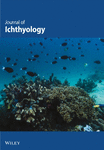A preliminary examination of depth associated spatial variation in fish assemblages on small artificial reefs
Abstract
Small concrete artificial reef modules (hemisphere-shaped, approximately 1.3 m diameter, 1 m high) were placed at two sites, eight modules per site. The sites were in 7 m and 21 m of water, 1.6 km apart, off the coast of southeast Florida, USA. The reefs were censused monthly for fish over a 19-month period. Species, number of fish, and estimated total length of each individual were recorded by divers using SCUBA. After the monthly census, all fish were removed from the reefs with a piscicide. A total of 88 species were recorded in the study, with significantly greater diversity on the deep reefs (monthly mean of 7.6 versus 3.0 shallow, P < 0.001, anova). There were also significantly more biomass (calculated from length), and more large fish (>5 cm) on the reefs at 21 m than at 7 m (P < 0.001). There were more small fish at the shallow site (P < 0.05). Although it is not clear what variable(s) associated with the two depths is responsible for the differences, these results highlight the potential differences in artificial reef and ambient environment interactions within a localized area.
Introduction
It is clear that site location is an important aspect of artificial reef function ( Bohnsack 1985 ; Antonini 1992) . Early site-selection criteria for artificial reefs were concerned mainly with substrate and distance from natural reefs. However, the use of artificial reefs has become progressively more sophisticated in concept. The use of artificial reefs has moved from attempts simply to increase recreational fisheries catch to include using the structures to manage multiple facets of the marine environment (e.g. resource protection and preservation; tourism; mitigation; fish and invertebrate recruitment and production) ( Seaman 1991) . The ability to use artificial reef structures effectively to accomplish these diverse goals depends, in turn, on an understanding of the potential interactions between the structure and the immediate environment in which they are placed.
Some work has been published on depth-associated differences in artificial reef function in marine environs. Interpretation of the results of these studies has been open to question. The reefs were usually constructed from materials of opportunity (derelict boats, concrete rubble, etc.) and thus differed among sites within a study (e.g. Chang 1985; Haughton 1989 ; Moffitt 1989 ; Relini 1989) . This non-uniform construction caused the structures to act as confounding variables when attempting to compare sites. Further, artificial reefs at a site often were not replicated at all, or had small sample sizes of two or three. Small sample size within or between sites made rigorous statistical comparisons of census data difficult (e.g. Chang 1985; Haughton & Aiken 1989; Moffitt et al. 1989 ; Relini & Relini 1989; Kruer 1992 ; Jara 1994) . The use of specially designed and constructed artificial reef modules can avoid some of the problems inherent in using materials of opportunity. Such reefs are readily constructed as identical replicates and can be deployed in numbers sufficient for robust statistical analysis. Reef Balls® are one example of such reefs. Reef Balls® are commercially available structures specifically designed and engineered to function as artificial reefs. These structures are moulded from concrete, relatively small (1–2 m diameter base, depending on the model, Fig. 1) and designed to stand alone.
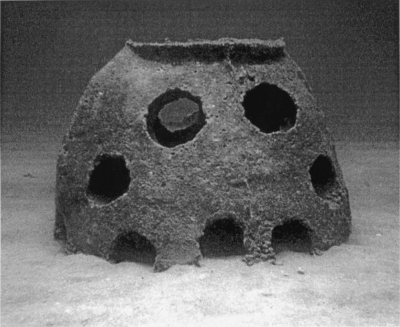
(P)hotograph of a Reef Ball® artificial reef deployed at 7 m depth off Fort Lauderdale, FL, USA
The objective of this study was to examine potential differences in fish recruitment and aggregation to artificial reefs off Broward County, Florida, USA. The near-shore marine environment off Broward County is characterized by three reef lines that run parallel to the coast in sequentially deeper water ( Goldberg 1973). Sandy, soft sediment habitat separates each reef line. Tracts of these sandy areas have been permitted as sites for artificial reef placement and numerous reefs, of varying material, have been deployed within these tracts since the 1970s. However, there have been no published studies examining potential differences in functionality between artificial reefs within these tracts. We compared fish assemblages at two specific artificial reef sites. The null hypothesis for this study was: there are no differences between fish assemblages, either in total fish, number of species, specific species, or total biomass that are recruited or attracted to artificial reefs placed at a shallow site or a deeper water site. The alternate hypothesis was: there are site-dependent differences in the fish assemblages between the two sites.
Materials and methods
The experimental design was straightforward. Eight Reef Ball® modules were placed at a permitted site in 7 m of water approximately 0.5 km off a beach at Fort Lauderdale, USA, (shallow site) and eight modules were placed at a site in 21 m of water 1.62 km due east of the shallow group (deep site). The fish associated with the eight modules at each of the two sites were compared. Because relevant physical and biological variables change seasonally, the fish were censused at monthly intervals, weather permitting.
Construction of the Reef Balls® was carried out at a local concrete plant (Rinker Materials Inc.). Waste concrete (uncured concrete remaining in trucks returning from job sites) was poured into fibreglass moulds supplied by Reef Ball Development Group Ltd. Sarasota, FL, USA. The dimensions of the individual modules (‘pallet balls’, Fig. 1) are 1.3 m × 1 m with a weight of approximately 850 kg. The modules are open at the top and have a large central void space. This space is created by a central bladder that is inflated for casting then deflated and removed after the concrete has hardened. Each module was formed with 18 side holes in a consistent pattern from pour to pour.
Deployment of the 16 modules took place in March 1995. The Reef Balls® were deployed by being towed, floating, to the sites by boat and then sunk by deflating the central bladder. The modules were placed approximately 25 m apart on sandy substrate, a minimum of 35 m from extensive hard bottom. After deployment the modules were tagged with cable ties and 6 cm plastic numbers from 1 to 8 at each site to facilitate underwater orientation and month-to-month comparisons. The general configuration of the eight modules at each site was of two parallel lines of four reefs each in a north–south direction.
The sites were censused 18 times over a 19-month period directly after the new moon, weather permitting (no census was made during October 1995). All fish within 1 m of a module (total volume of 7 m3) were counted and recorded with pencil and slate by a diver using SCUBA. The diver began counting the large fishes (>10 cm) when he was approximately 5 m from the module, then moved closer to count small resident and cryptic fishes. Horizontal visibility at the sites, during censusing, ranged from 7–25 m over the period of the study. The fish were placed in one of five size intervals based on total length (TL): <2, 2–5, 5–10, 10–20, >20 cm. These intervals were marked on the edge of the slate and used in estimating fish length. Biomass was calculated, using mean interval length, from published length–weight equations ( Bohnsack 1988) . When a species-specific equation was not available, the equation for a congeneric was used. Each month, after counting, the modules were cleaned of fish with a piscicide (ChemFish, Tifa (C.I.) Limited, Millington, NJ, USA). Statistical analysis of the resulting data was accomplished by analysis of variance ( anova), and the Student–Newman–Keuls test between means (SNK) using SAS (SAS Institute Inc., Cary, NC, USA) software.
Results
The results of the 18 censuses indicated significantly more species at the deep modules (monthly mean of 7.6 deep and 3.0 shallow, P < 0.001, anova, Fig. 2). Eighty-eight species were recorded, 81 species on the deep modules and 44 on the shallow. Forty-three species were found only on the deep modules while only six were unique to the shallow modules ( Table 1). There was a significant month-to-month variation in the number of species (P < 0.001, anova, Fig. 3) on both the deep and shallow modules with the greatest numbers found during the second summer (i.e. April–August 1996, deep; June–September 1996, shallow). Families identified only on the deep Reef Balls® include: Muraenidae, Holocentridae, Apogonidae and Pomacentridae. Bothidae was the only family restricted to the shallow Reef Balls®. Family Serranidae was found exclusively at the deep Reef Balls® site, with the exception of Diplectrum formosum (sand perch).
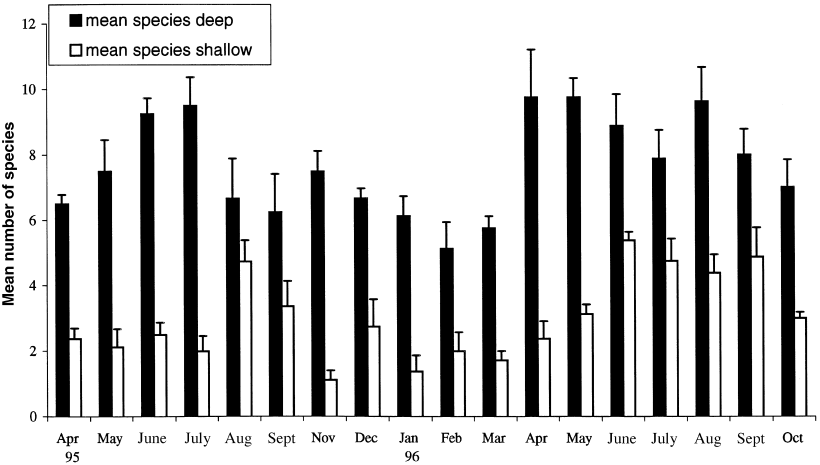
)ean (+1 SE) number of fish species per reef, by month, in deep and shallow water
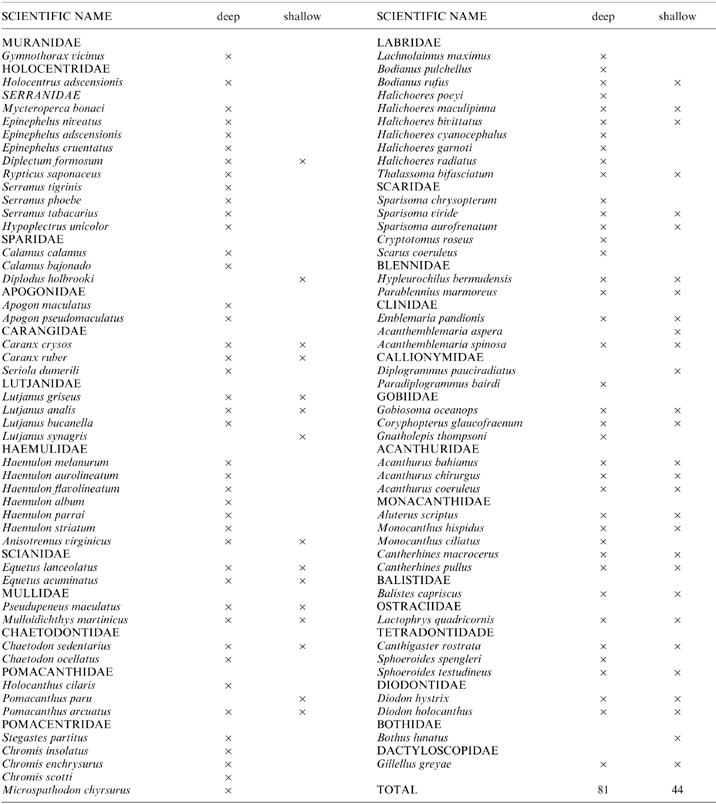
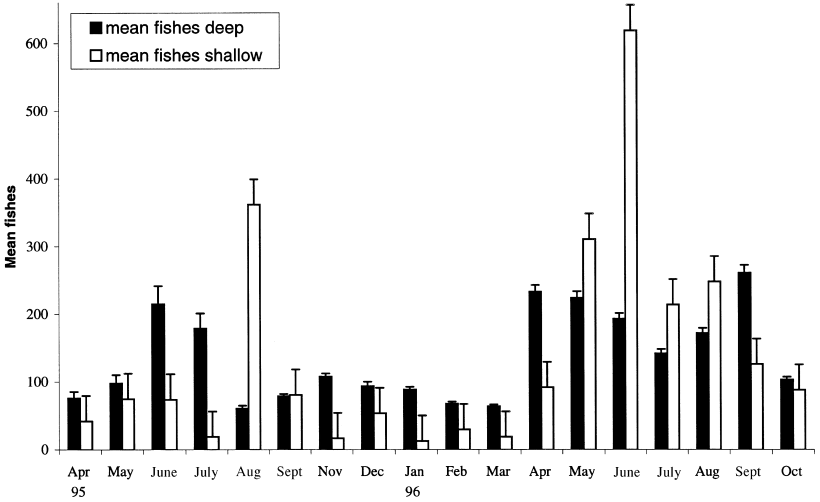
)ean (+1 SE) number of total fish (all species combined), for all reefs within each site, by month in deep and shallow water
Total recruits (juvenile fish <5 cm TL) at the shallow site equalled 92% of the fish counted, while at the deep site total recruits made up 61% of the fish counted. Most of the juvenile fish were grunts (Haemulidae). They made up 76% of the total number of fish counted at the shallow site and 24% of the total number of fish at the deep site. Although there was no site-associated difference in the total numbers of fish (all species combined) between the two sites (P > 0.05, anova, Fig. 3), the fish of the three larger size intervals aggregating to the reefs (5–10, 10–20, >20 cm) were more abundant on the deeper modules throughout the year (P > 0.001, anova). A two-way anova indicated recruits (0–5 cm) were more abundant on the shallow reefs over the period of the study (P < 0.001) and differed among months at both sites (P < 0.05, anova). Recruitment peaked at the shallow site during the summer months (August 1995 and June 1996, P > 0.05, SNK, Fig. 3). Species contribution to the total number of fish differed among the sites. In addition to mixed schools of juvenile grunts, common individual species at the shallow site include: Acanthemblemaria aspera (roughhead blenny) 7.1% of the total fish and Anisotremus virginicus (porkfish) 3.3%. Other common species at the deep site include: Thalassoma bifasciatum (bluehead wrasse) 11.9%, Coryphopterus glaucofraenum (bridled goby) 5.7%, Haemulon melanurum (cottonwick) 5.6%, Canthigaster rostrata (sharpnose puffer) 4.3%, Diplectrum formosum (sand perch) 4.2%, and Apogon pseudomaculatus (twospot cardinalfish) 4.1%.
Total estimated biomass was greater on the deep modules for all size intervals (P < 0.001, anova, Fig. 4). Although often an important factor in fisheries assessment, biomass can be misleading in a study examining recruitment. Because juvenile fish are small, their contribution to an assemblage in terms of numbers may be under appreciated using only biomass calculations. For example, 76% of the fish at the shallow site were juvenile grunts under 5 cm (total biomass: 336 g) yet the biomass of a single 20 cm porcupine fish (487 g) constituted a greater percentage of the total biomass. Another example, stated differently, is total biomass on the deep Reef Balls® in August 1996 was approximately 7000 g while the total biomass for juveniles during that same period was approximately 28 g. The total fish on the deep reefs in August 1996 was 172, out of which 76 were juveniles (<5 cm TL). Therefore, 44% of the total fish accounted for only 0.3% of the total biomass.
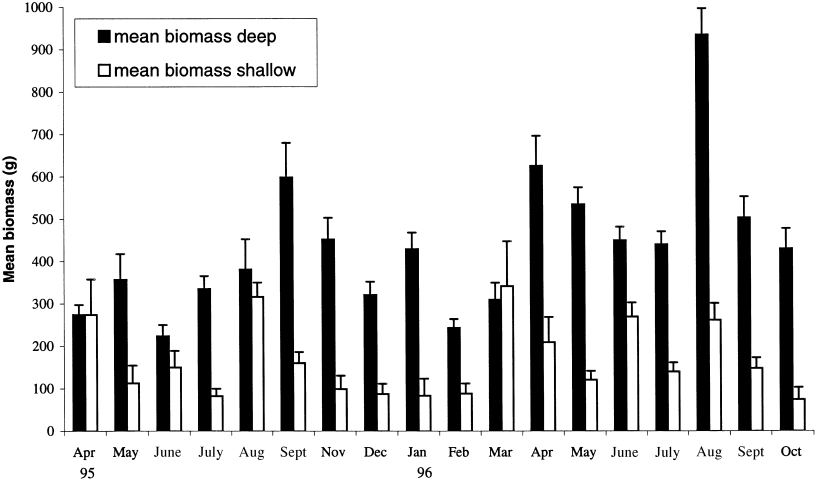
)ean (+1 SE) biomass of fish per month in deep and shallow water
Discussion
Contrary to the null hypothesis significant differences were found in most variables between monthly fish assemblages on deep and shallow modules, i.e. total fish (by size interval), recruits, species and biomass. In an unrelated study, a different design of reef module placed at the same depths as the reefs in this study had similar depth-associated differences among the fish assemblages (authors unpublished). These findings have important implications for the deployment of artificial reefs. For example, in the area of this study, an artificial reef intended to increase recruitment of grunts, e.g. as a forage base for piscivorous game fish, would be better placed in shallow water; a reef intended to acquire a diverse assemblage of fish, or specific serranids, in deep. However, further research is required to determine if recruitment or aggregation to artificial reefs at either site would significantly add to the local populations of fish.
There are a number of variables that change relative to water depth (e.g. light, current, temperature, pressure). In this first-look study no attempt was made to experimentally determine the specific physical or biological variables associated with water depth that could cause differences in fish assemblages. Thus, at this point, the factor(s) responsible for the site-associated differences recorded are not known. The encrusting community of algae and invertebrates may differ between the two sites. However, differences in fish aggregations were noted very early in the study (i.e. April 1995), prior to the formation of a substantial encrusting community. Thus, it is doubtful that differences in substrate or attached food are major factors in determining site-associated differences in this study. The possibility of differences in benthic soft-bottom biota affecting the results can not be discounted.
One important physical factor may be current. Although differences in current between the shallow and deep water sites were not measured, it was apparent from the dives and observed scouring around the modules that the current was substantially greater at the deep site. Occasionally the current at the deep site was such that divers had to pull themselves by hand along the substrate and were unable to complete a census. Similar currents were not noted at the shallow site. Current may interact with the fish assemblages and the reef modules in several ways. For example, increased current brings more competent (ready to settle) larval fish that are in the water column in contact with the reefs per given unit of time; brings more planktonic food to a reef per given unit of time; and can scour out additional refugal spaces in the sand substrate. Also, reefs, in turn, offer some protection from the current to aggregating fish.
A direct comparison between the present work and previously published research is difficult for the reasons already mentioned (differing reef materials and low sample sizes). However, although the materials and methodology differ greatly among these studies and the present study, the previously published results also support a conclusion of depth-associated differences in fish recruitment and aggregation to artificial reefs. Kruer & Causey (1992), in a study in southeast Florida, examined both artificial and natural reefs at three depths, monthly, over a 2-year period. Their emphasis, however, was on standing crop rather than recruitment. They found an increase in species diversity and total numbers of fish with increasing depth at natural reef sites but artificial reefs in 14 m had higher numbers of species and fish than identical reefs at 24 m. They attributed this difference to increased scouring creating more microhabitats at the 14 m site.
Likewise, the studies carried out by Chang (1985), Haughton & Aiken (1989), and Moffitt et al. (1989) support the hypothesis that fish recruitment and aggregation varies significantly with depth. Relini (1994) and Jara & Cespedes (1994) carried out studies of algae, invertebrates, and fish in the northern Mediterranean and southern Chile, respectively, and also found assemblage variation with depth.
In summary, the local placement of artificial reefs (according to depth) may affect significantly both recruitment, aggregation, and the resultant make-up of the fish assemblages. In this study there were significant differences in fish aggregations between reefs at depths of 7 and 21 m that were less than 2 km apart. The results of this study indicate the potential importance of depth as a determinant in artificial reef function. Fisheries managers need to take this into account when determining a deployment site for an artificial reef; the site selected should be the optimum to meet the management goals of a specific artificial reef.
Acknowledgements
Kenneth Banks of Broward County Department of Natural Resources Protection (DNRP) and Todd Barber of Reef Balls® Development Group Ltd. offered constructive comments on the initial stages of this study. Rinker Materials Corp. Inc. donated the concrete as well as work and storage space. Joseph Ligas (DNRP) was responsible for most of the reef construction. Louis Fisher, Cynthia Corbett-Elder, David Stout (DNRP) aided in reef deployment. Barry Klinger provided mathematical consultation. Several students from Nova South-eastern University acted as dive partners during census taking. This research was funded in part by grants from Florida Department of Environmental Protection and Broward County Department of Natural Resource Protection to R.E.S. and an Aylesworth Foundation for the Advancement of Marine Science-Florida Sea Grant fellowship to R.L.S.



